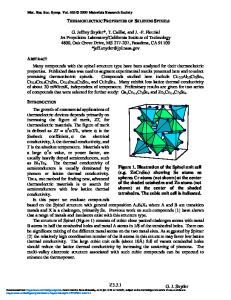Thermoelectric Properties of Some Cobalt Phosphide-Arsenide Compounds
- PDF / 67,902 Bytes
- 6 Pages / 612 x 792 pts (letter) Page_size
- 21 Downloads / 362 Views
Thermoelectric Properties of Some Cobalt Phosphide-Arsenide Compounds Anucha Watcharapasorn*, Robert C. DeMattei†, and Robert S. Feigelson*† Department of Materials Science and Engineering, Stanford University, Stanford, CA 94305, U.S.A. † Laboratory for Advanced Materials, McCullough Bldg., Rm. 119, Stanford University, Stanford, CA 94305-4045, U.S.A. *
Thierry Caillat, Alexander Borshchevsky, G. Jeffrey Snyder, and Jean-Pierre Fleurial Jet Propulsion Laboratory, California Institute of Technology, MS 277/207, 4800 Oak Grove Drive, Pasadena, CA 91109, U.S.A. ABSTRACT Samples of CoP3, CoAs3 and CoP1.5As1.5 have been synthesized and their thermoelectric properties measured. All three samples show semiconducting behavior. The Seebeck coefficients of CoP3 and CoAs3 are weakly dependent on temperature and are relatively small with maximum values of about 40 and 50 µV/K, respectively. The Seebeck coefficient of the solid solution gradually decreases with increasing temperature and the values are larger than those of CoP3 and CoAs3 in the temperature range investigated, with a maximum value of about 89 µV/K near room temperature. The thermal conductivity of CoP3 and CoAs3 are higher than that of CoSb3, as can be expected from the effect of anionic size on lattice vibration. A substantial reduction in thermal conductivity was observed for the solid solution compared to the constituent binary compounds due to additional phonon scattering from lattice disorder and other possible point defects such as vacancies. Other compositions in the CoP3-xAsx system have also been synthesized and their thermoelectric properties are currently being investigated to provide essential information about lattice thermal conductivity reduction by point defect scattering and to further develop strategies for optimizing the thermoelectric properties of skutterudite materials. INTRODUCTION Over the last decade, a large number of skutterudite materials have been synthesized and their thermoelectric properties studied. Large ZT values have been obtained for CeFe4-xCoxSb12 (0
Data Loading...










